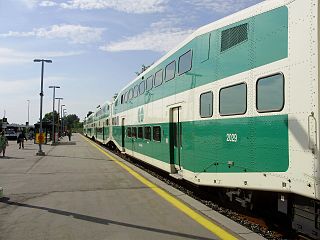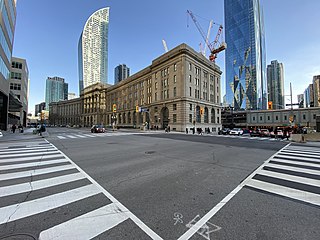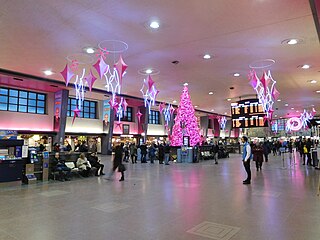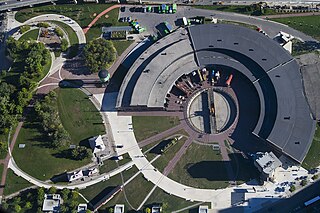
Union Station is a major railway station and intermodal transportation hub in Toronto, Ontario, Canada. The station is located in downtown Toronto, on Front Street West, on the south side of the block bounded by Bay Street and York Street. The municipal government of Toronto owns the station building while the provincial transit agency Metrolinx owns the train shed and trackage. It is operated by the Toronto Terminals Railway, a joint venture of the Canadian National Railway and Canadian Pacific Railway, which directs and controls train movement along the Union Station Rail Corridor, the largest and busiest rail corridor in Canada. Constructed in 1927, Union Station has been a National Historic Site of Canada since 1975, and a Heritage Railway Station since 1989.

Harbourfront is a neighbourhood on the northern shore of Lake Ontario within downtown Toronto, Ontario, Canada. Part of the Toronto waterfront, Harbourfront extends from Bathurst Street in the west, along Queens Quay, with its ill-defined eastern boundary being either Yonge Street or York Street. Its northern boundary is the Gardiner Expressway. Much of the district was former water lots filled in during the early 1900s to create a larger harbour district. After shipping patterns changed and the use of the Toronto Harbour declined, the area was converted from industrial uses to a mixed-use district that is mostly residential and leisure.

The Toronto waterfront is the lakeshore of Lake Ontario in the city of Toronto, Ontario, Canada. It spans 46 kilometres between the mouth of Etobicoke Creek in the west and the Rouge River in the east.

Spadina Avenue is one of the most prominent streets in Toronto, Ontario, Canada. Running through the western section of downtown, the road has a very different character in different neighbourhoods.

Barrie is one of the seven train lines of the GO Transit system in the Greater Toronto Area, Ontario, Canada. It extends from Union Station in Toronto in a generally northward direction to Barrie, and includes ten stations along its 101.4 kilometres (63.0 mi) route. From 1982 to 1990 and again from 1993 to 2007, it was known as the Bradford line, named after its former terminus at Bradford GO Station until the opening of Barrie South GO Station.

Front Street is an east–west road in downtown Toronto, Ontario, Canada. First laid out in 1796, the street is one of the original streets of the Town of York. The street was laid out along the shoreline of Lake Ontario as it existed during that time. It remains an important street, with many important uses located along it, including the St. Lawrence Market, Meridian Hall, Union Station and the Metro Toronto Convention Centre. The eastern section of Front Street, in the West Don Lands, east of Cherry Street, is being rebuilt as a broad tree-lined boulevard, intended to be the pedestrian-friendly commercial spine of the new neighbourhood.

Montreal Central Station is the major inter-city rail station and a major commuter rail hub in Montreal, Quebec, Canada. Nearly 11 million rail passengers use the station every year, making it the second-busiest train station in Canada, after Toronto Union Station.

The Kingston railway station is an inter-city passenger rail station in Cataraqui, Kingston, Ontario, Canada. It is served by Via Rail trains running from Toronto to Ottawa or Montreal, along the Corridor route. It is located on John Counter Boulevard, northeast of Princess Street and northwest of downtown Kingston.

London station in London, Ontario, Canada is a major interchange for Via Rail trains running from Toronto west to Sarnia and Windsor. The station is a large, modern, wheelchair accessible building on the south end of the city centre, and connects to local public transit bus services.

The CNR Spadina Roundhouse was owned by the Canadian National Railway, built in 1928. The purpose of Spadina Roundhouse was the pretrip inspection, service and repairing of the motive power of passenger trains, including locomotives and Budd Rail Diesel Cars terminating, or originating at Toronto Union Station.

CityPlace is a neighbourhood in Downtown Toronto, Ontario, Canada, within the former Railway Lands. When completed, this area will be the largest residential development ever created in Toronto. The area is bordered by Bathurst Street to the west, Lake Shore Boulevard to the south, and Front Street to the north and Blue Jays Way and Rogers Centre to the east. Cityplace is also a five-to-ten-minute walk from King Street West and Liberty Village and a ten-to-twenty-minute walk from Toronto's financial district. The neighbourhood is also home to the Canoe Landing Park, designed by famed Canadian writer and artist Douglas Coupland.

Downtown Toronto is the main city centre of Toronto, Ontario, Canada. Located entirely within the district of Old Toronto, it is approximately 16.6 square kilometres in area, bounded by Bloor Street to the north, Lake Ontario to the south, the Don Valley to the east, and Bathurst Street to the west. It is also the home of the municipal government of Toronto and the Government of Ontario.

Roundhouse Park is a 17-acre (6.9 ha) park in the downtown core of Toronto, Ontario, Canada. It is in the former Railway Lands. It features the John Street Roundhouse, a preserved locomotive roundhouse that houses the Toronto Railway Museum, Steam Whistle Brewing, and the Rec Room restaurant and entertainment complex. The park is also home to a collection of trains, the former Canadian Pacific Railway Don Station, and the Roundhouse Park Miniature Railway. The park is bounded by Bremner Boulevard, Lower Simcoe Street, Lake Shore Boulevard West/Gardiner Expressway, and Rees Street.
The Old Canadian National rail yard in Edmonton was once the centre of economic activity in that city. Its redevelopment has fundamentally altered the appearance of the city. The former yard occupied a long, narrow strip from 103 Avenue to 105 Avenue north to south and from 101 Street to 116 Street east and west.

The SkyWalk is an approximately 160 metre enclosed walkway connecting Union Station to the CN Tower and the Rogers Centre (SkyDome) in Toronto, Ontario, Canada. Part of Toronto's PATH network, the SkyWalk passes above the York Street 'subway' and the Simcoe Street Tunnel and runs roughly parallel between Front Street and Bremner Boulevard.

Riverdale Railway Station was located on De Grassi Street just north of Queen Street East in Toronto, Ontario, Canada. Constructed by the Grand Trunk Railway (GTR) in 1896 as "Queen East Station", on what is now the Lakeshore East line, the station was renamed "Riverdale Station" in 1907. The Canadian National Railway (CNR) took over the station in 1923, when they absorbed the Grand Trunk Railway. CNR discontinued passenger train service at the station in 1932, later for commercial use and demolished the building in 1974.

Via Rail's Toronto Maintenance Centre is a railway yard in the western end of Toronto, which stores and services Via trains. It lies within the south side of the former Canadian National Mimico Yard directly opposite of the Willowbrook Rail Maintenance Facility on the north side; GO Transit's Lakeshore West line separates the two facilities. The yard is bisected by the Islington Avenue flyover bridge. Its main entrance is located at 50 Drummond Street on the eastern side with a secondary entrance on its southern side along New Toronto Street at Eighth Street.

The Esplanade is an east-west street along the central waterfront of Toronto, Ontario, Canada. This neighbourhood consists of generally low-rise and mid-rise housing - condominiums, public housing, cooperatives and some town homes between Jarvis and Parliament Streets south of Front Street. The stretch between Scott Street and Market Street is a popular restaurant area.

The Union Station Rail Corridor (USRC) is a corridor of railway tracks that exist through and adjacent to Union Station in downtown Toronto. It is 6.4 kilometres long, approximately stretching from Bathurst Street in the west to the Don River in the east, making it the largest rail passenger facility in Canada.
Rail Deck Park is a proposed large urban park in Downtown, Toronto, Ontario, Canada. Announced on August 3, 2016, the park will be set on a constructed deck that encloses the active Railway Lands between Bathurst Street and Blue Jays Way, west of the Rogers Centre. In total, the park will span 8.5 hectares when constructed. As of November 2017, the City of Toronto estimated the park to cost $1.66 billion. In May 2020, the Canadian Taxpayers Federation released a study saying that once exclusions from the city's estimates are factored in the park would cost more than $3.7 billion.
























